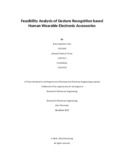| dc.contributor.advisor | Bhuian, Mohammed Belal Hossain | |
| dc.contributor.author | Taki, Khan Sakib Nur | |
| dc.contributor.author | Tonny, Jannatul Ferdous | |
| dc.contributor.author | Nahin, S.H.M | |
| dc.date.accessioned | 2023-09-19T06:42:48Z | |
| dc.date.available | 2023-09-19T06:42:48Z | |
| dc.date.copyright | 2022 | |
| dc.date.issued | 2022-11 | |
| dc.identifier.other | ID 15321005 | |
| dc.identifier.other | ID 15321011 | |
| dc.identifier.other | ID 15321018 | |
| dc.identifier.uri | http://hdl.handle.net/10361/21017 | |
| dc.description | This thesis is submitted in partial fulfillment of the requirements for the degree of Bachelor of Science in Electrical and Electronic Engineering, 2022. | en_US |
| dc.description | Cataloged from PDF version of thesis. | |
| dc.description | Includes bibliographical references (pages 46-49). | |
| dc.description.abstract | The Oximeter is commonly used on the finger tips for better analysis of the oxygen saturation
on the blood. Still there are some errors to be aware of during the scans. It has a tendency to
be accuracy 90% of the time. Furthermore, if there are possibilities to get some errors from
scanning the part of the body with less skin density such as fingers, scanning on the wrist will
have far more errors than this. Yet, from comparing the two measurements we can find the
difference between the error and add them on the taken analysis to get the actual result.
Now it is as simple as adding the error of the analysis gap we get both the wrist and the
fingertip. After comparing with the market best oximeter with the reading of different
individuals the accuracy has been checked and corrected. This system can be efficient for
monitoring the COVID-19 patients as they mostly face the falling oxygen saturation sta | en_US |
| dc.description.statementofresponsibility | Khan Sakib Nur Taki | |
| dc.description.statementofresponsibility | Jannatul Ferdous Tonny | |
| dc.description.statementofresponsibility | S.H.M Nahin | |
| dc.format.extent | 55 pages | |
| dc.language.iso | en | en_US |
| dc.publisher | Brac University | en_US |
| dc.rights | Brac University theses are protected by copyright. They may be viewed from this source for any purpose, but reproduction or distribution in any format is prohibited without written permission. | |
| dc.subject | HRM | en_US |
| dc.subject | ESP8266 wifi module | en_US |
| dc.subject | MAX30100 sensor | en_US |
| dc.subject | Bpm | en_US |
| dc.subject | MCU | en_US |
| dc.subject | MAXHR | en_US |
| dc.subject | LED | en_US |
| dc.subject | IoT | en_US |
| dc.subject.lcsh | Electronic circuit design--Computer programs | |
| dc.subject.lcsh | Internet of things | |
| dc.title | Feasibility analysis of gesture recognition based human wearable electronic accessories | en_US |
| dc.type | Thesis | en_US |
| dc.contributor.department | Department of Electrical and Electronic Engineering, Brac University | |
| dc.description.degree | B. Electrical and Electronic Engineering | |

